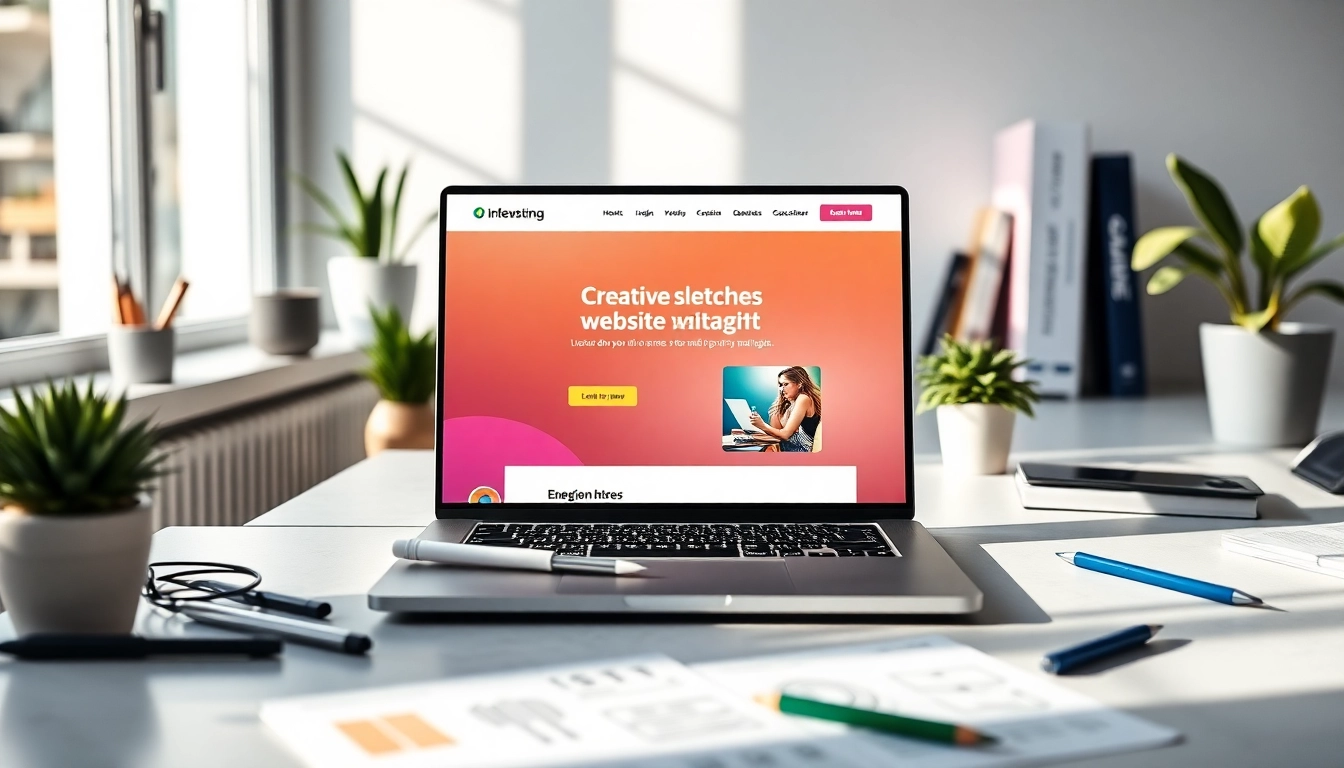Understanding Website Design Fundamentals
Defining Website Design and Its Importance
Website design refers to the process of planning, conceptualizing, and arranging content intended for the internet. It encompasses various aspects, including web graphic design, user interface design, authoring, and standardized coding. At its core, effective website design aims to create an engaging and user-friendly experience that meets the needs of both the site owner and visitors. Given that your website is often the first point of contact with your audience, its design plays a pivotal role in shaping perceptions and guiding user interactions.
When done correctly, website design enhances user retention, boosts conversion rates, and elevates brand reputation. A well-designed website can significantly differentiate a company from its competitors, ensuring that it not only attracts visitors but also has the potential to turn them into loyal customers. Thus, understanding the importance of website design is fundamental for achieving overall business success.
Key Elements of Successful Website Design
Successful website design consists of several essential elements, each contributing to the overall effectiveness of the site:
- Visual Appeal: The aesthetics of a website, including layout, color schemes, and typography, should reflect the brand’s identity and purpose.
- Usability: A website must be easy to navigate, enabling users to find the information they need quickly without confusion.
- Responsiveness: With increasing mobile usage, websites must be designed to adapt to various devices and screen sizes, providing a seamless experience no matter how users access the site.
- Content Quality: Engaging, relevant, and high-quality content is crucial in retaining visitor interest and providing value.
- Loading Speed: Fast-loading pages are essential as delays can lead to higher bounce rates, negatively impacting user experience and SEO rankings.
Common Mistakes in Website Design to Avoid
Even seasoned designers can make mistakes that undermine the effectiveness of a website. Here are common pitfalls to watch out for:
- Neglecting Mobile Users: Failing to implement responsive design can alienate a significant portion of users who access websites through mobile devices.
- Overcomplicating Navigation: Complex navigation structures can frustrate users. Clear, straightforward menus improve usability.
- Ignoring SEO Best Practices: A stunning design is wasted if the website is not optimized for search engines, making it difficult for users to find.
- Forgetting to Test: Regular testing for different browsers and devices ensures that the website performs well across platforms.
- Using Too Many Fonts or Colors: This can create a chaotic appearance. Consistency in design elements promotes a professional look.
Modern Trends in Website Design
Responsive Website Design for Mobile Users
As mobile devices become the primary means of accessing the internet, responsive website design has become a necessity. This design approach allows websites to adapt their layout and content according to the size of the screen being used, ensuring an optimal viewing experience. Techniques like fluid grids, flexible images, and CSS media queries play crucial roles in achieving this adaptability.
Responsive design not only boosts user satisfaction but also improves SEO performance, as search engines favor mobile-friendly websites in their rankings. Therefore, investing in responsive design is essential for any business aiming to reach a broad audience effectively.
Utilizing Minimalism in Website Design
Minimalist design focuses on simplicity and functionality. This trend emphasizes the use of fewer elements, such as text and images, creating a cleaner and more organized appearance. By prioritizing essential content and eliminating distractions, minimalist design can enhance usability and improve conversion rates.
In addition to aesthetic appeal, a minimalist approach can lead to faster loading times, further enhancing user experience. Common practices include employing ample white space, straightforward typography, and a limited color palette that reflects the brand and its message.
Incorporating Interactive Features in Website Design
Interactive elements, such as animations, sliders, and embedded videos, can engage users more effectively than static content. By creating dynamic experiences, websites can capture attention and encourage prolonged interaction. For instance, hover effects can guide users, while personalized content recommendations can cater to individual preferences.
Incorporating interactivity requires careful attention to user experience, as overly complex features may distract rather than enhance. The key is to balance interactions with usability to provide a seamless and enjoyable experience.
Website Design Principles for Enhanced User Experience
Color Theory and Its Impact on Website Design
Color plays a vital role in web design, as it affects user emotions and behaviors. Understanding color theory can help designers create harmonious palettes that resonate with their target audience. For instance, colors can evoke feelings of trust, excitement, or calmness, and should align with the brand’s overall message.
A site’s color scheme should also ensure accessibility. Adequate contrast is essential not only for aesthetic purposes but also for users with visual impairments. Tools like contrast checking applications can help designers select appropriate colors to enhance legibility and accessibility.
Typography Choices in Website Design
Typography is an often-overlooked yet critical component of website design. The choice of fonts can influence readability, establish hierarchy, and convey the brand’s personality. Designers should consider using a limited number of fonts for consistency and coherence across the site.
Additionally, font size and line spacing can enhance readability, especially on mobile devices. Prioritizing clear and legible typography contributes significantly to user experience and content comprehensibility.
Creating Intuitive Navigation for Website Design
Well-structured navigation is essential for guiding users through a website. Intuitive navigation ensures visitors can easily find information without having to search excessively. Key best practices include organizing content logically, using clear labels for navigation items, and ensuring navigation is accessible from every page.
Implementing a breadcrumb trail can further guide users, showing them their location within the site and enabling easy backtracking. Ultimately, streamlined navigation can significantly reduce bounce rates and enhance user satisfaction.
Tools and Resources for Effective Website Design
Popular Software Solutions for Website Design
Numerous software solutions are available to aid in website design, catering to various skill levels—from novice to expert. Design tools can range from comprehensive integrated development environments (IDEs) to specialized graphic design software. Some common categories include:
- Graphic Design Software: For creating visuals, logos, and layouts, programs like Adobe Photoshop or Illustrator are industry standards.
- Website Builders: Platforms like Wix or Squarespace offer user-friendly interfaces, enabling users to build attractive websites without extensive coding knowledge.
- CMS Platforms: Content Management Systems like WordPress allow users to manage website content effectively while offering extensive customization options through themes and plugins.
- Prototyping Tools: Tools like Figma and Adobe XD allow designers to create visual representations of a website before development, facilitating collaboration and feedback.
Utilizing Templates in Website Design
Website templates can expedite the design process by providing a foundation on which to build. They offer a pre-designed layout that users can customize to fit their branding and content needs. While templates can save time and ensure aesthetic appeal, it’s crucial to modify them enough to stand out from similar sites using the same templates.
By leveraging templates, designers can maintain a focus on high-quality content and functionality, ensuring an efficient and effective design process.
Building a Website Design Portfolio
A portfolio showcases a designer’s skills and creativity, serving as a critical tool for attracting potential clients. It should highlight diverse projects that demonstrate technical ability, problem-solving skills, and design versatility. Key elements to include are:
- Case Studies: Detail the design process for each project, including challenges faced, the solutions implemented, and the outcomes achieved.
- Visual Presentations: High-quality images or interactive prototypes can provide a clear understanding of the designer’s work.
- Personal Branding: Consistency in branding across the portfolio enhances professionalism, making it easily recognizable.
Measuring Success in Website Design
Key Performance Indicators for Website Design
Measuring the success of website design requires establishing key performance indicators (KPIs) to evaluate effectiveness. Common metrics include:
- Traffic Analytics: Tools like Google Analytics can provide insights on visitor behavior, including page views, bounce rates, and average session duration.
- Conversion Rates: Tracking the percentage of visitors who complete desired actions (e.g., signing up, making a purchase) can measure design effectiveness in achieving business goals.
- User Engagement: Engagement metrics, such as comments, shares, and time spent on the site, reflect the quality of content and design.
Gathering User Feedback on Website Design
User feedback is invaluable for assessing the success of website design. Surveys, usability tests, and feedback forms can provide insights into user preferences and areas for improvement. Techniques to gather feedback include:
- Post-Interaction Surveys: Prompting users for their thoughts immediately after they interact with key features can yield helpful insights.
- A/B Testing: Running variations of design elements can help identify the most effective options based on user responses.
- Focus Groups: Direct discussions with users can unveil deeper insights about their experience and satisfaction levels.
Iterating on Website Design Based on Analytics
Analyzing performance data is crucial for continuous improvement. Regularly reviewing user interaction metrics and feedback can inform design iterations. The approach involves:
- Identifying Patterns: Tracking user behavior trends over time helps pinpoint which design elements resonate or fall short.
- Implementing Changes: Based on data-driven decisions, implementing regular updates can enhance user experience and meet evolving audience needs.
- Monitoring Outcomes: Continuously assess the effects of changes to ensure they produce the desired results.



